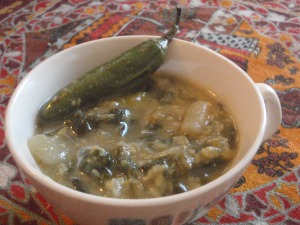
dueling dals---mung dal left, urad dal right
All dalled up and nowhere to go. Nowhere I need to go right now anyway, and that’s great ’cause it’s cold and wet out and holidays—and rhinovirus round-robin– have done done me in. Here are two different Indian-style dals to warm your hearth and belly. The first, a mung dal based creamy chowder chunked with plenty of radishes (softened to mellowness), comes together straightforwardly. Urad dal provides the base for the second soup, the small skinned and split beans swimming swimmingly with diced kohlrabi, caressed by silky slips of spinach. Though requiring multiple steps, the assembly is not tricky, and the process yields a flavor and texture quite distinct from the mung dal potage, despite the a similar brassical and leafy constituency.
All that and dal is a cheap source of good nutrition, too. I usually buy mine at Fiesta because I don’t make it up to MGM as often as I’d like. The pressure cooker makes quick work of a pot of legumes, but you can simmer these soups the old-fashioned way if you’re not pressure-equipped. Boil the dals 20 to 30 minutes before adding your vegetables, then continue to simmer until the base is cooked before finishing the recipe.
If you’ve got basmati rice on hand, enjoy it with these dals. I always have a cooked pot of Texas-grown Lowell Farms organic jasmine rice in the fridge, so that’s my usual dal dais.

mung dal and rice
EASY MUNG DAL WITH RADISHES makes a potful
- ¾ cup mung dal, picked through for pebbles and the like, well-rinsed and drained
- 6 cups water
- 1 to several cloves organic garlic
- 1 bay leaf. Grow your own if you can. Bay needs little care.
- heaping ½ teaspoon turmeric
- 1 ½ teaspoons salt. I like Real Salt.
- 1 Tablespoon ghee or butter, plus 2 Tablespoons ghee (not butter). See my simple instructions for making ghee.
- 1 or 2 bunches of local radishes, sliced about 1/6 ” thick. If the greens look sprightly, chop ’em up, too.
- 1 teaspoon cumin seeds
- 1 dried red chile. Crush it up for some heat or leave it whole to accommodate the kids.
- ¼ teaspoon asafetida powder. This stinky spice, with its natural antiviral compounds, shows promise as an H1N1 fighter.
- ½ to a whole local onion, quartered and slice thin
- ¼ teaspoon salt
- chopped fresh local cilantro to taste. A cool weather treasure around here.
Combine the mung dal, water, garlic, bay leaf, turmeric, salt and 1 Tablespoon butter in a 6-quart pressure cooker. Bring up to high pressure on high heat, lower the heat to maintain the pressure and cook for 5 minutes. Remove from the heat and let the pressure drop for 10 minutes before releasing the pressure with the quick-release mechanism. Carefully remove the lid (watch out for the steam!), and add the radishes and greens, if using. Replace the lid and bring to high pressure again over high heat. Cook at high pressure for another 5 minutes, remove from heat and let the pressure drop for 10 minutes before releasing the pressure and removing the lid—be careful!
While the dal rests, heat the ghee and cumin seeds in a medium skillet over medium-high heat. If your stove top is electric, you can use the same burner to save energy. Add the chile. When the cumin smells as toasty as you like, add the asafetida, followed quickly by the onion slices. Add the salt and stir it all around. Continue to cook, stirring frequently, until the onion is well-browned. When fully browned, stir the onion mixture into the dal, put the lid on the pot and let the dal sit for a couple minutes to infuse.
Stir in the cilantro and serve, ladled over rice if you wish, with a squeeze of lemon if desired.
This soup is seasoned with a wet masala . (Masala means spice mixture.) The technique is easy and results in a more mellow rendering of the spices’ essence.
 URAD DAL WITH KOHLRABI makes a potful
URAD DAL WITH KOHLRABI makes a potful
- ¾ cup urad dal, picked through for pebbles and such, well-rinsed and drained
- 6 cups water
- 1 to several cloves organic garlic
- 1 bay leaf
- 1 teaspoon salt. I like Real Salt.
- heaping ½ teaspoon turmeric
- dab of ghee or butter, plus 3 or 4 Tablespoons ghee (not butter). See my simple instructions for making ghee.
- 3 medium-sized local kohlrabi, trimmed and very well peeled, diced
- 1 bag Cora Lamar’s Texas-grown savoy spinach (10 ounces). Triple washed and ready to cook, you needn’t prep it further. Available at Central Market, today it’s on sale for $2.50 a bag.
- 1 local onion, quartered and sliced thin
- ¼ teaspoon salt
- 1 teaspoon cumin seeds
- 1 teaspoon coriander seeds
- ½ teaspoon fennel seeds
- 6 black peppercorns
- medium pecan shell-sized lobe of ginger root, minced
- ¼ teaspoon asafetida powder
- 1 medium-sized mild whole green chile, if available, halved, seeded and sliced. You probably won’t be finding any more local peppers at our markets right now. If you’ve got one leftover, use it. If not, just leave it out.
Combine dal, water, garlic, bay leaf, salt, turmeric and dab of ghee in a 6-quart pressure cooker. Bring up to high pressure over high heat, lower the heat to maintain the pressure and cook for 5 minutes. Remove from the heat and let the pressure drop for 10 minutes before releasing the pressure with the quick-release mechanism. Carefully remove the lid (watch out for the steam!), and add the kohlrabi and spinach. Replace the lid and bring to high pressure again over high heat. Cook at high pressure for another 5 minutes, remove from the heat and let the pressure drop for 10 minutes before releasing the pressure and removing the lid, carefully!
While the dal is cooking, heat up a couple tablespoons of ghee with the onion slices and ¼ teaspoon salt in a small to medium skillet. Stir and cook, regulating the heat as necessary to thoroughly brown the onion. This will take a while, don’t try to rush it. Meanwhile, grind the whole spices (cumin through peppercorns) in a spice grinder. Combine with the ginger and a few tablespoons of water.
While the dal pot enjoys its second 10 minute rest, use the hot burner to heat up another couple of tablespoons or so of ghee in a medium skillet (you can use a small one if you’re out of peppers). When the ghee is hot, dump in the asafetida, followed quickly by the chile slices. Saute the peppers until they pick up some brown spots, then add the wet ground spice mixture. Stir and fry until the masala dries but hasn’t scorched. Stir the spices and onions into the cooked dal and let the soup rest for a couple minutes before correcting the salt, if needed, and serving with rice, if desired.

















